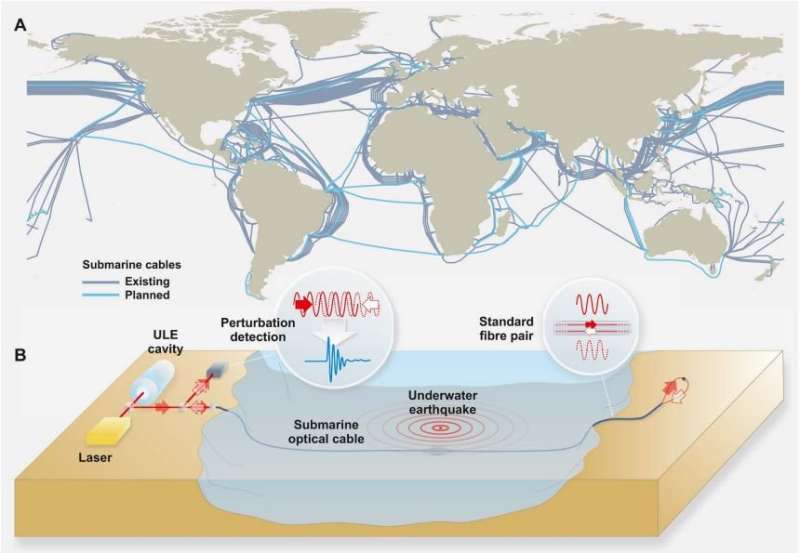June 15, 2018 report
A way to use underwater fiber-optic cables as seismic sensors

A team of researchers from the U.K., Italy and Malta has found a way to use fiber-optic cables already on the ocean floor as seismic detectors. In their paper published in the journal Science, the team describes how they made their discovery and how it would work.
As the researchers note, there are approximately 1 million kilometers of fiber-optic cable strewn across the bottom of the world's oceans carrying internet and telecom traffic. In this new effort, the researchers have come up with a way to use them as seismic detectors. Doing so, they note, would offer a whole new perspective on the planet's seismic activity—70 percent of Earth, they note, is covered with water, which means very little overall seismic activity is currently being recorded.
The researchers report that one of their members, Giuseppe Marrawere, was testing an underground cable between two locations in the U.K. He noticed a small slowdown in signal delivery and traced it to tiny vibrations bending the light. The vibrations, he discovered, were caused by a remote earthquake. That inspired the idea of looking into using such cables as seismic detectors.
The group reports that they found existing fiber-optic cables could be used as seismic detectors by testing the idea with some real underwater (and under land) cables. They also found that the cables could be used in this way without disruptions to service and without having to make any changes to the cables. All that would be needed would be to gain access to one of a group of channels on both ends of a cable. Each side would be fitted with a special laser-based detector to continually monitor the signal. And that, they further note, would amount simply to renting a channel, or better yet, convincing the owner of the cable to donate it to a research group.
The researchers suggest that if enough of the cables under the oceans were used as seismic monitors they could offer access to unprecedented types of information—information that could be used to predict tsunamis, for example, or to better understand global seismic activity as it relates to plate shifting and volcanism.
More information: Giuseppe Marra et al. Ultrastable laser interferometry for earthquake detection with terrestrial and submarine cables, Science (2018). DOI: 10.1126/science.aat4458
Abstract
Detecting ocean-floor seismic activity is crucial for our understanding of the interior structure and dynamic behavior of the Earth. However, 70% of the planet's surface is covered by water and seismometers coverage is limited to a handful of permanent ocean bottom stations. We show that existing telecommunication optical fiber cables can detect seismic events when combined with state-of-the-art frequency metrology techniques by using the fiber itself as the sensing element. We detected earthquakes over terrestrial and submarine links with length ranging from 75 to 535 km and a geographical distance from the earthquake's epicenter ranging from 25 to 18,500 km. Implementing a global seismic network for real-time detection of underwater earthquakes requires applying the proposed technique to the existing extensive submarine optical fiber network.
Journal information: Science
© 2018 Phys.org



















